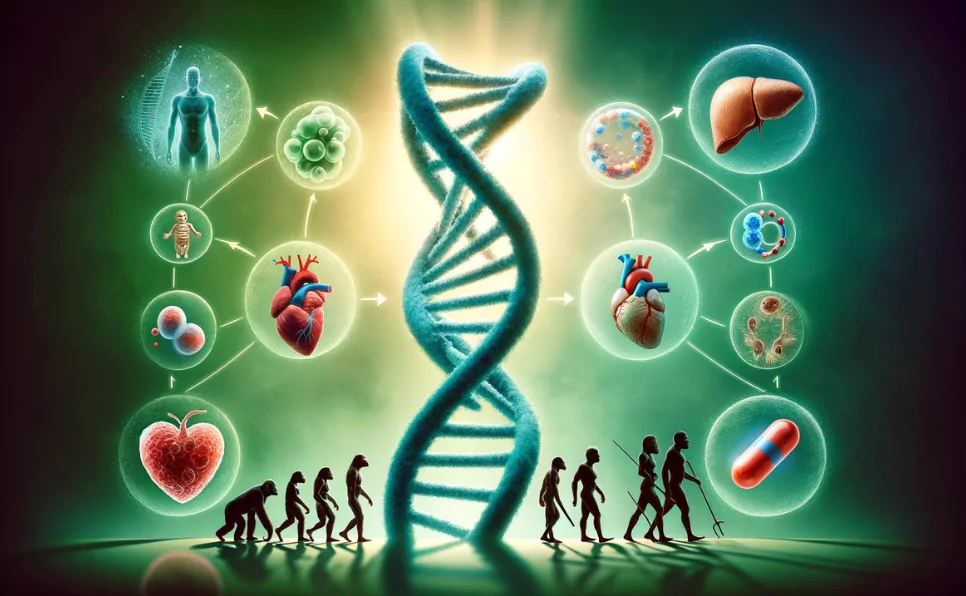When we think about what makes us human, we often consider culture, language, or perhaps our use of tools.
But beneath all that, it’s our genetics that have a massive say in shaping who we are, how we live, and even what diseases we might face.
Genetics is at the core of our being, influencing everything from our appearance to our susceptibility to certain diseases.
This is why understanding genetic mutations is so crucial, especially when it comes to human diseases. It’s not just about knowing what’s wrong; it’s about understanding why, and how we’ve evolved alongside these conditions.
The Basics of Genetics and Human Evolution
What is DNA and Genetic Mutations
DNA is like a blueprint for building and running our bodies. It’s made up of genes, which are instructions for making proteins, the workhorses of our cells.
Sometimes, these instructions change, or mutate, and that’s what we call a genetic mutation.
These mutations can be silent, or they can lead to changes in how proteins function, which can affect health and development.
Mutations are a double-edged sword.
On one hand, they’re the reason we can adapt and survive in a changing world.
On the other, they can lead to diseases.
The Mechanism of Natural Selection and Its Impact on Genetics
Natural selection is nature’s way of choosing the traits that are best suited for survival in a given environment.
It’s all about survival of the fittest. Traits that enhance survival and reproduction become more common in a population over time.
This is how species, including humans, evolve.
For example, the ability to digest lactose as adults is a beneficial mutation that became common in populations that domesticated cattle.
It’s fascinating how such small changes at the genetic level can have a big impact on human populations.
Tracing the Genetic Roots of Human Diseases
Common Genetic Diseases and Their Evolutionary Origins
Now, let’s dive into how genetics and disease are intertwined.
Some diseases have clear genetic links. Take sickle cell anemia, for instance. It’s caused by a mutation that makes red blood cells sickle-shaped, leading to various health issues.
But, this mutation also provides resistance against malaria, which is why it’s more common in regions where malaria is prevalent.
It’s a striking example of how a disease trait can have a protective advantage against another condition.
Across different populations, we see a variety of genetic diseases that have evolved due to our ancestors’ environments and lifestyles. It’s a complex interplay between genetics and the world around us.
The Impact of Genetic Drift and Founder Effects
Not all genetic variations are due to natural selection. Some are just random.
That’s where genetic drift comes in. It’s a process that can cause gene frequencies to change over time purely by chance.
Then there’s the founder effect, which occurs when a new population is established by a very small number of individuals from a larger population.
This can lead to rare alleles (different forms of a gene) becoming much more common in the isolated population.
Isolated populations, like those on islands or in remote valleys, often have unique disease susceptibilities due to these effects.
It’s a reminder of how our history, geography, and chance events can shape the health of future generations.
Modern Humans and the Genetic Legacy of Disease
In our journey through time, the genetic makeup of humans has adapted to the environments we’ve lived in, the pathogens we’ve encountered, and the diets we’ve consumed.
These adaptations have been a double-edged sword, offering protection against certain conditions while making us more vulnerable to others.
This delicate balance between advantage and susceptibility is particularly evident when we look at modern diseases such as diabetes and obesity.
The Double-Edged Sword of Genetic Adaptations
Our ancestors’ environments played a significant role in shaping our genetic predispositions.
For instance, populations in malaria-prevalent regions developed the sickle cell trait, a mutation in the hemoglobin gene that provides resistance to malaria.
However, this same mutation can lead to sickle cell disease, a condition with its own set of health challenges, when inherited from both parents.
Genetic adaptations have made us more susceptible to modern diseases like diabetes and obesity.
This susceptibility is not just about the genes we’ve inherited; it’s also about how those genes interact with our current lifestyle.
The diets and sedentary lifestyles of today do not match the “hunter-gatherer” conditions our genetic profiles were initially adapted to thrive in.
The result? A spike in lifestyle-related diseases.
- Diabetes: Certain genetic mutations that once provided advantages, like the ability to store fat more efficiently during times of food scarcity, now contribute to diabetes in an era of food abundance.
- Obesity: Similarly, genes that predisposed our ancestors to store energy in fat tissues are now liabilities in our calorie-rich, physically inactive world.
This mismatch between our genetic makeup and modern lifestyle choices underscores the complexity of human health and disease.
Genetic Diseases in the 21st Century
The prevalence of genetic diseases today is a stark reminder of our evolutionary past and its impact on current health outcomes.
Conditions such as cystic fibrosis, hemophilia, and various forms of cancer have genetic roots and continue to affect millions worldwide.
However, it’s not all grim. Advances in genetic technology for disease prevention and treatment are moving at a rapid pace, offering hope for conditions that were once considered untreatable.
Techniques like gene therapy, where defective genes are replaced with functional ones, are already making strides in treating diseases like spinal muscular atrophy and certain forms of blindness.
The Future of Genetic Research in Human Health
As we look to the future, the field of genetics holds the key to unlocking many mysteries of human health and disease.
Cutting-edge technologies are not just about treating diseases; they’re about preventing them, understanding them, and, in some cases, even eradicating them.
Cutting-Edge Technologies in Genetics
- CRISPR: This technology has revolutionized genetic research by allowing scientists to edit genes with unprecedented precision, efficiency, and flexibility. The potential to correct mutations that cause genetic diseases is one of its most exciting applications.
- Gene Therapy: This approach involves inserting healthy genes into a patient’s cells to replace or repair faulty ones, offering potential cures for a range of genetic disorders.
- Personalized Medicine: Leveraging genetic information to tailor medical care to the individual patient is a growing trend. It’s about creating treatments that are as unique as the genetic makeup of the person they are designed to treat.
“The potential future breakthroughs in treating genetic diseases could redefine our approach to healthcare.”
Ethical Considerations in Genetic Manipulation
With great power comes great responsibility.
The ability to edit genes, while offering immense potential for good, also raises significant ethical questions. The ethical dilemmas of genetic editing and designer babies are at the forefront of discussions among scientists, ethicists, and the public alike.
- How do we balance the potential for curing diseases with the risk of creating new ones?
- Where do we draw the line between therapeutic applications and enhancements?
- What are the societal implications of gene editing, especially in terms of equity and access?
The balance between genetic research and moral values is a delicate one.
As we advance, it’s crucial to ensure that the benefits of genetic research are accessible to all, not just a privileged few, and that they do not come at the expense of ethical principles.
Final Thoughts
The crucial role of genetics in understanding human evolution and disease cannot be overstated. Our genetic makeup holds the key to unlocking the mysteries of diseases that have plagued humanity for centuries.
The importance of genetic research for future medical advancements is clear. As we continue to unravel the genetic basis of diseases, we open the door to more effective treatments, preventive strategies, and, ultimately, a healthier future for all.
FAQs
How do genetic mutations occur?
Genetic mutations happen when DNA changes during cell division, exposure to certain chemicals, or damage from UV rays. These changes can be inherited or acquired, affecting how cells behave. Mutations are a natural part of evolution, sometimes beneficial but can also lead to diseases.
Can genetic diseases be prevented or cured?
With advancements in genetic research, many genetic diseases can now be prevented through screening and lifestyle changes. Cures are emerging, notably through gene therapy, where faulty genes are replaced or repaired, offering hope for diseases once deemed incurable.
What is the significance of genetic diversity in human populations?
Genetic diversity is crucial for survival, enabling populations to adapt to changing environments and resist diseases. It’s the genetic variation among individuals that contributes to a species’ flexibility and resilience against external threats.
How does gene therapy work?
Gene therapy works by delivering a correct copy of a gene into a patient’s cells, compensating for defective ones. This can be done using vectors like viruses to carry and insert the healthy gene, aiming to treat or cure genetic diseases by restoring normal function.
What are the ethical implications of gene editing?
The ethical implications of gene editing include concerns over safety, consent, and the potential for inequality. Debates focus on the distinction between therapeutic uses versus enhancements, and the risk of unforeseen consequences, emphasizing the need for careful consideration and regulation.
For Further Reading:
- Impact of mutation rate and selection at linked sites on DNA variation across the genomes of humans and other Homininae – Genome Biology and Evolution
- Fitness effects of mutations throughout evolution – Nature Reviews Genetics
- Genetics of human brain development – Nature Reviews Genetics
- Massive genetic study shows how humans are evolving – Nature

Dr. Sumeet is a seasoned geneticist turned wellness educator and successful financial blogger. GenesWellness.com, leverages his rich academic background and passion for sharing knowledge online to demystify the role of genetics in wellness. His work is globally published and he is quoted on top health platforms like Medical News Today, Healthline, MDLinx, Verywell Mind, NCOA, and more. Using his unique mix of genetics expertise and digital fluency, Dr. Sumeet inspires readers toward healthier, more informed lifestyles.





